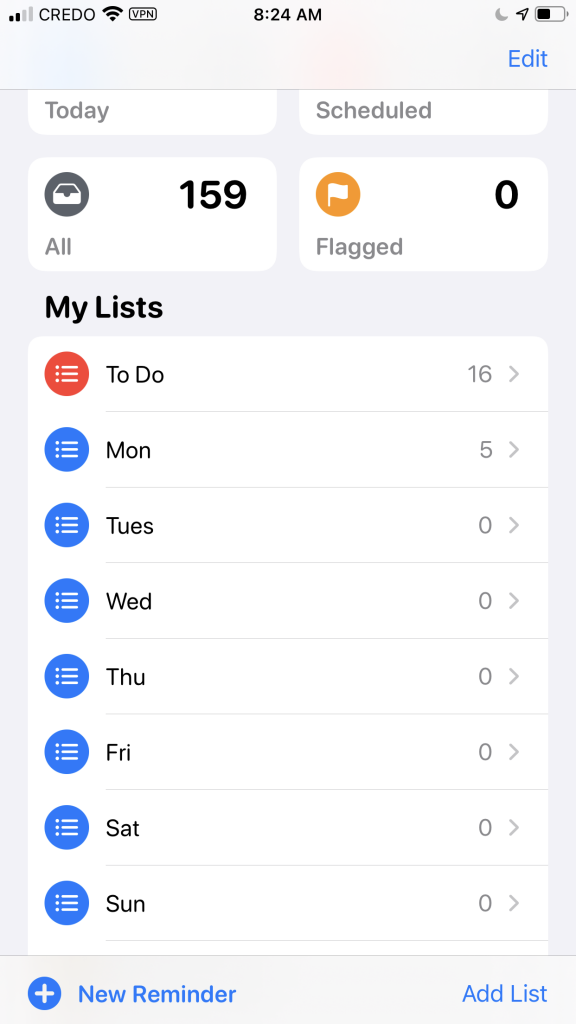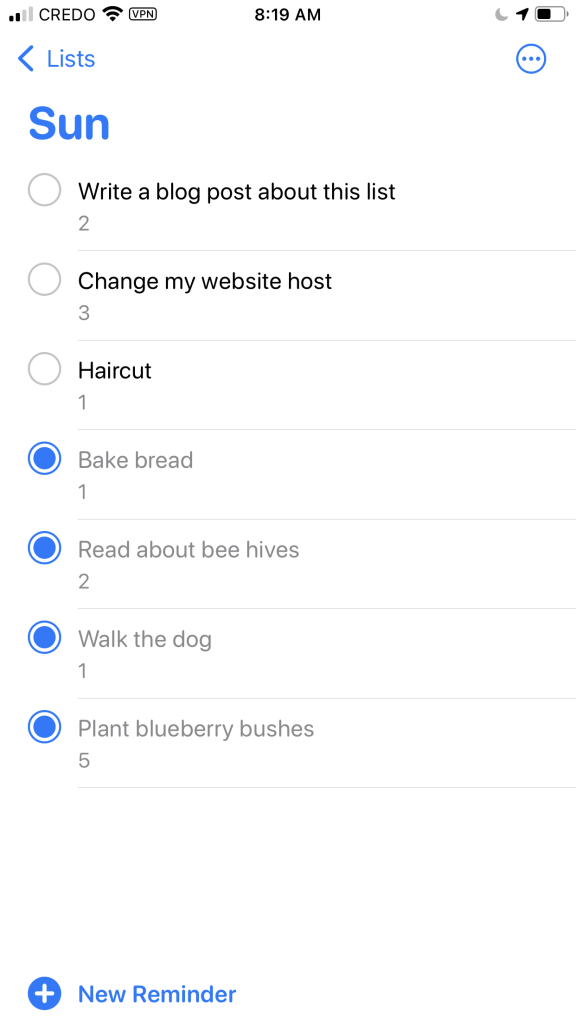I heard myself saying things like “My list of things to do just keeps getting longer!” and “There aren’t enough hours in the day.” I also noticed I was often scrambling to finish things at the end of my day, rushing to cross something off my list before dinner or evening plans or bedtime. I also noticed that I don’t have this problem at work. With rare exceptions, I complete projects on schedule and move pretty systematically through my work days/weeks.
Why did I feel productive at work but not in my personal life? My partner would regularly accuse me of trying to “do too much.” So, like a nerdy engineer, I did an experiment. I started “sizing” the tasks on my list of things to do. It was a simple exercise, but the impact of this experiment has changed my life.
Sizing in 37 seconds
The method I’m using to size tasks comes from the Agile methodology, which is popular in the tech industry. In order to plan and complete projects reliably, there is a heavy emphasis on accurately estimating levels of effort. Two important concepts make this possible. (There’s a lot more to learn about this, but it’s not necessary for present purposes.) First, we break down large tasks into smaller, more manageable chunks. Secondly, we acknowledge risk and unpredictability, which tend to increase exponentially with the size of the task. In other words, the bigger the job, the bigger the margin of error. With these concepts in mind, we size individual tasks using abstract points that reflect the difficulty and/or the complexity.
My point system
There are many ways to score tasks, but I’m a fan of the classic Fibonacci sequence: 1, 2, 3, 5, 8, 13, 21… Notice that as the numbers get larger, the gaps between the scores get increasingly wide. It’s important to understand that the scores don’t represent fixed intervals of time, like hours or days. They represent any unit of effort that you choose. Here’s what I came up with for myself:
- 1 point tasks are quick and very easy. Basically, the smallest chores that are still worth reminding myself to do. Examples: running the laundry machine, making an important phone call, writing an email.
- 2 point tasks are easy, but might require a little bit of troubleshooting. Something that might take me up to an hour. Examples: Read a chapter of a book, make an online purchase that requires some research.
- 3 point tasks are moderately easy, but involve several variable factors, or enough uncertainty that it might require more than an hour. For me, tasks often graduate from 2 points to 3 when they involve leaving the house to shop for something. This higher score adds the uncertainty of traffic, checkout lines, etc.
- 5 point tasks are “small projects” that I might loosely set aside an afternoon to accomplish. At least a few hours of work, but not all day.
- 8 point tasks are proper projects that are large enough to define my day if someone asked “What are you doing today?”. The most frequent example of this is my actual day job.
- 13 point tasks are theoretically possible in a single “marathon” day (the kind when you set the alarm clock early and finish late at night). This score is mostly a placeholder in my system, because they can (and probably should) be broken down into smaller sub-tasks.
Great. But what do you do with a list of tasks that have arbitrary numbers assigned to them? We are close to figuring out how much can get done in a day because we now have a way to quantify daily effort or productivity. We’ll figure out the daily rate next.
How many points fit in a day?
Figuring out how many points fit into a day is easy. In the very beginning you just guess! For the first week, I ignored the scores and used my intuition to just added what felt like a day of tasks to my daily to do list, just like I’ve always done. Throughout the day, I kept track of the tasks I completed. Some days I got close to finishing everything, but usually I came up short.
Now comes the fun part. At the end of the week, I reviewed each day and counted up the points for the tasks I actually completed each day. Initially, I thought this might vary a lot from day to day, but I was surprised to find that almost every day I completed almost exactly 15 points. Some days were off by a point or two, but it quickly became clear that 15 points was the realistic number of points I could expect to accomplish in a single day. This insight was a huge victory for me, and it changed my life in surprising ways.
Life-changing results
I’m not exaggerating when I say that this experiment changed my life. I now have a pretty good idea of what I can realistically accomplish in my spare time. This is incredibly helpful for planning and accomplishing life goals. It is also good for my mental health because I no longer find myself struggling to accomplish an unrealistic amount of work every day. Instead of continually failing to accomplish an aspirational list of a daily tasks, I now regularly succeed at accomplishing a realistic list of tasks. There have been other benefits, as well.
The exercise of scoring individual tasks encourages me to think about tasks in more granular terms so my list tends to have smaller, more manageable tasks. In the past, I might have added something like Make a chicken coop to my list. But after the exercise of sizing this task, I end up with something like this: Find a chicken coop design (2), Calculate / list necessary materials (1), Buy materials from the hardware store (3), Construct the coop (5). Instead of one monolithic, all-day project that I won’t ever get around to, I have a handful of fairly straightforward tasks that I can (and will) do gradually. This is an old productivity trick.
I also find that the daily ritual of compiling my daily list makes me much more purposeful about the way I spend my day. In the past, instead of making a hard choice between two important tasks, I would just add them both to the list and hope for the best. This allowed fate to decide my priorities. Now, I make a conscious decision about what will happen first. Or, if they really are both equally important, it suggests maybe something else on the list needs to get punted until later.
The most surprising side-effect of my new system is that I feel much less stress. The daily “budget” of points allows me to modulate the amount of pressure I put on myself. A list of things to do represents an expectation, which is a form of pressure. The longer the list, the more pressure I tend to feel. The old way of working off a single, long list of things to do was problematic because I wasn’t in control of the overall length. Splicing off a finite daily sub-list fixes this problem because it allows me to adjust the length strategically. If 15 points represents a realistic amount of productivity (for me) for a normal day, I might decide to give myself a break and only do 10 points. Or, if I’m feeling ambitious and I can add in an extra task or two. By deciding what to include on the list, I am able to curate that expectation. It has been a huge relief to escape the constant weight of everything on my main list.
The most beautiful things about this system is that it also allows me to feel “done” at the end of a day. This is a gift. I didn’t realize how precious it was because I was never able to feel it when I used to look at at my single, giant backlog of tasks.
Tools and tactics
There are infinite ways that one could implement a system like this, but I believe it is most important to figure out a system that fits with the ergonomics of your life. The best system is the one that works for you. I’m going to describe the tools that I’m currently using, but my goal is not to suggest this is the best way. It just happens to be what worked for me.
I carry an iPhone, and I was already using the built-in Reminders app, so I expanded on that. First, I keep one master “To Do” list which is where I add any new tasks that I want to accomplish. I use the optional Notes field to put the numeric score. I like this because it appears below the name of the task in the list view. Then, I have seven individual lists for each day of the week. Every morning, while I sip my first cup of tea, I clear that day’s list and move items from the main To Do list into that day’s list. I might order them a little bit if the timing is obvious, but I don’t overthink this. It’s not a sequence. I mark the items as completed as I do them throughout the day. (This is the best part). I turn on the “Show completed” option because I find it rewarding to see the progress. At the end of the day, if something didn’t get done, I move it back to the main list. Occasionally, if something new springs up during the day, I’ll add something directly to that day’s list, but this usually means I need to move something off of that day’s list to make space.


Conclusion
This started as a goofy experiment, but it made a big difference in my life. Stay curious and keep tinkering! If anything about this helps you, or you have even better ideas, please let me know.